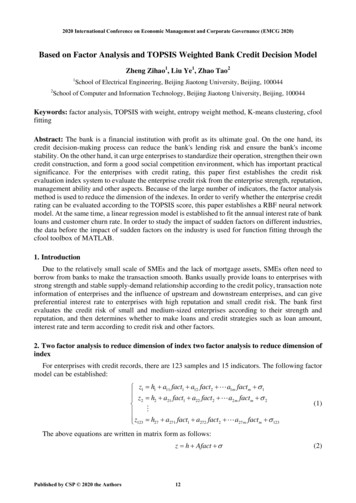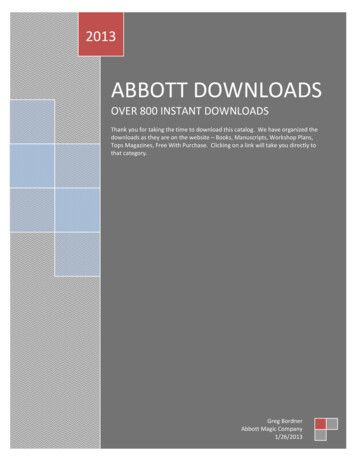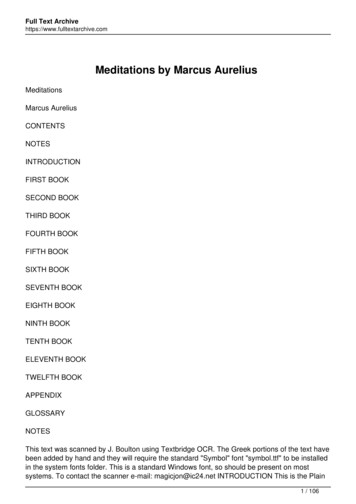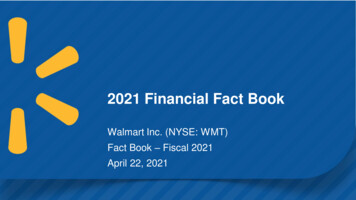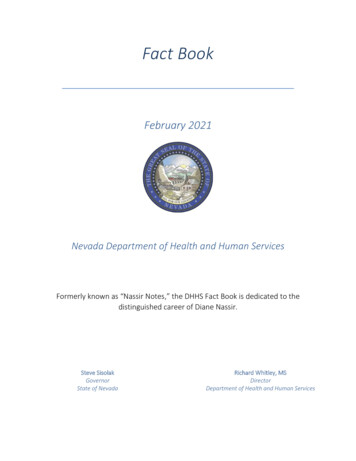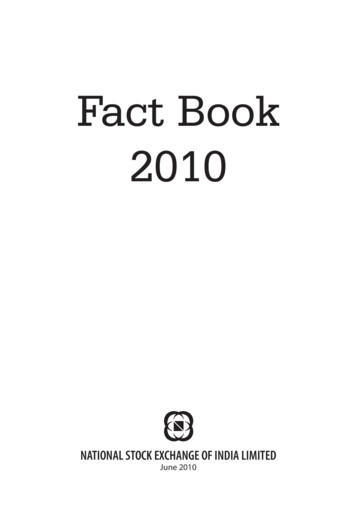
Transcription
Fact Book2010NATIONAL STOCK EXCHANGE OF INDIA LIMITEDJune 2010
CONTENTSSECTION 1- NATIONAL STOCK EXCHANGE OF INDIAIntroduction . 3Incorporation and Management .3Market Segments And Products .3Achievements/Milestones . 5Developments during the year.6Facts And Figures . 8Technology . 8NSE Family . 11NSCCL . 11NSDL . 12NSE Infotech services Ltd . 12NSE.IT . 12IISL. 12Dotex International Ltd. . 12NCDEX . 13NCCL . 13PXIL. 13SECTION 2- MEMBERSHIP ADMINISTRATIONEligibility Criteria. 19Trading Membership . 19Clearing Membership . 20Currency Derivative Membership . 20Growth and Distribution Of Members. 20SECTION 3- LISTING OF SECURITIESListing Criteria . 27Listing Agreement . 27Compliance By Listed Companies . 27Disclosures By Listed Companies . 28De-Listing . 28CM Segment . 29Listing Fees . 30Shareholding Pattern . 30WDM Segment . 30Contd.i
Contd.Funds Mobilisation On the Exchange . 31Initial Public Offerings (IPO’s) . 32Rights Issues . 32Preferential Allotment/ Private Placement. 32QIPs . 32SECTION 4- CAPITAL MARKET SEGMENTNEAT - CM System. 49Market Performance. 49Trading Volume . 49Liquidity . 50Distribution of turnover . 51Market Capitalisation . 52Sectoral Distribution of Top 50 Companies . 52Trading Records during 2008-09 . 53Internet Trading . 53On-line IPOs . 54Indices . 54Mutual Funds And Exchange Traded Funds . 56Charges . 57Clearing & Settlement . 58Settlement Agencies . 59Settlement Cycles . 60Settlement Statistics . 60Risk Management System . 60Capital Adequacy . 60On-Line Monitoring . 60Margin Requirements . 61Categorisation of newly listed securities . 61Value at Risk Margin . 61Extreme Loss Margin . 62Mark to Market Margin . 62Close out Facility . 62Index –based Market wide Circuit Breakers. 63Settlement Guarantee Fund . 63Contd.ii
Contd.SECTION 5- WHOLESALE DEBT MARKET SEGMENTTrading Mechanism . 87Market Performance. 88Turnover. 88Market Capitalistion . 90Transaction Charges . 90Settlement . 90FIMMDA-NSE MIBID/MIBOR . 90Zero Coupon Yield Curve . 91NSE-VAR System . 92GOI- bond Index. 93SECTION 6- FUTURES &OPTIONS SEGMENTTrading Mechanism . 107Contract Specification . 107Selection Criteria For Stocks And Index Eligibility For Trading . 108Trading Value & Contracts Traded. 109Product wise turnover on F&O segment . 110Futures and Options on Benchmark Indices . 111Sectorwise Stock Futures & Options Turnover . 111Participant wise turnover on F&O Segment . 112Member wise turnover on the Exchange . 113High Volume Members . 113Internet Trading . 113Traded Value Records . 113Top 20 Futures And Options Contracts . 114Number of Trades . 114Charges . 114Clearing And Settlement. 115Clearing Mechanism . 115Settlement Mechanism . 116Settlement Statistics . 117Risk Management System . 117NSE-SPAN . 118Margins . 119Position Limits . 119Contd.SPAN is a registered trademark of the Chicago Mercantile Exchange (CME) used here under license.iii
Contd.SECTION 7- CURRENCY DERIVATIVES SEGMENTTrading Mechanism . 143Contract Specifications for Currency Futures . 143Turnover. 145Traded Value Records . 146Clearing and Settlement. 146Clearing Entities . 146Clearing Mechanism . 146Settlement Mechanism . 146Settlement Statistics . 147Margining System . 147Position Limits for Currency Futures . 151Risk Management . 151SECTION 8- INVESTOR SERVICES, ARBITRATIONInvestor Services . 157Arbitration . 157SECTION 9- KNOWLEGDE INITIATIVEAbout NSE’s Certification in Financial Markets (NCFM) . 163New Modules introduced under NCFM in 2009-10 . 163NSE’s Certified Capital Market Professionals (NCCMP) . 164CBSE- NSE joint Certification in Financial Markets . 164NSE’s Certified Capital Market Professionals (NCCMP) . 164NSE – Manipal Education Training Programs . 165NSE Research Initiative . 166Investor Awareness and Education Programmes . 166iv
National Stock Exchangeof India1
2
National Stock Exchange of India1Since its inception in 1992, National Stock Exchange of India has been at the vanguard of changein the Indian securities market. This period has seen remarkable changes in markets, from howcapital is raised and traded, to how transactions are cleared and settled.The market has grown in scope and scale in a way that could not have been imagined at the time.Average daily trading volumes have jumped from 17 crore in 1994-95 when NSE started its CashMarket segment to 16,959 crore in 2009-10. Similarly, market capitalization of listed companieswent up from 363,350 crore at the end of March 1995 to 6,009,173 crore at end March 2010.Indian equity markets are today among the most deep and vibrant markets in the world.NSE offers a wide range of products for multiple markets, including equity shares, ExchangeTraded Funds (ETF) , Mutual Funds, Debt instruments, Index futures and options, Stock futures andoptions, Currency futures and Interest rate futures. Our Exchange has more than 1,400 companieslisted in the Capital Market and more than 92% of these companies are actively traded. The debtmarket has 4,140 securities available for trading. Index futures and options trade on four differentindices and on 190 stocks in stock futures and options as on 31st March , 2010. Currency futurescontracts are traded in four currency pairs. Interest Rate Futures (IRF) contracts based on 10 year7% Notional GOI Bond are also available for trading.Incorporation and ManagementNSE was incorporated in November 1992, and received recognition as a stock exchange underthe Securities Contracts (Regulation) Act, 1956 in April 1993. It is managed by professionals whodo not directly or indirectly trade on the Exchange. The trading rights are with trading memberswho offer their services to the investors. The Board of NSE comprises of senior executives frompromoter institutions and eminent professionals, without having any representation from tradingmembers. While the Board deals with the broad policy issues, the Executive Committees (ECs),which include trading members, formed under the Articles of Association and the Rules of NSE fordifferent market segments, set out rules and parameters to manage the day-to-day affairs of theExchange. The day-to-day management of the Exchange is delegated to the Managing Director whois supported by a team of professional staff. Therefore, though the role of trading members at NSEis to the extent of providing only trading services to the investors, the Exchange involves tradingmembers in the process of consultation and participation in vital inputs towards decision making.Tables 1-1 and 1-2 gives the composition of its Board of Directors and the Executive Committees.Market Segments and ProductsNSE provides a trading platform for of all types of securities for investors under one roof – Equity,Corporate Debt, Central and State Government Securities, T-Bills, Commercial Paper (CPs),Certificate of Deposits (CDs), Warrants, Mutual Funds (MFs) units, Exchange Traded Funds (ETFs),Derivatives like Index Futures, Index Options, Stock Futures, Stock Options Currency Futures andInterest Rate Futures. The Exchange provides trading in 4 different segments viz., Wholesale DebtMarket (WDM) segment, Capital Market (CM) segment, Futures & Options (F&O) segment and theCurrency Derivatives Segment (CDS).The Wholesale Debt Market segment provides the trading platform for trading of a wide range ofdebt securities which includes State and Central Government securities, T-Bills, state developmentloans (SDLs), bonds issued by public sector undertakings (PSUs), floating rate bonds (FRBs),zero coupon bonds (ZCBs), index bonds, commercial papers (CPs), certificate of deposits (CDs),3
corporate debentures, SLR and non-SLR bonds issued by financial institutions (FIs), bonds issuedby foreign institutions and units of mutual funds (MFs).However, along with these financial instruments, NSE also launched various products e.g. FIMMDANSE MIBID/MIBOR owing to the market need. NSE also started the dissemination of its yet anotherproduct, the ‘Zero Coupon Yield Curve’. This helps in valuation of sovereign securities across allmaturities irrespective of its liquidity in the market. The increased activity in the governmentsecurities market in India and simultaneous emergence of MFs (Gilt MFs) had given rise to theneed for a well defined bond index to measure the returns in the bond market. NSE constructedsuch an index, ‘NSE Government Securities Index’. This index provides a benchmark for portfoliomanagement by various investment managers and gilt funds. The average daily turnover in theWDM Segment was 2,359 crore (US 523 million) during 2009-10.The Capital Market (CM) segment offers a fully automated screen based trading system, knownas the National Exchange for Automated Trading (NEAT) system. This operates on a price/timepriority basis and enables members from across the country to trade with enormous ease andefficiency. Various types of securities e.g. equity shares, warrants, debentures etc. are traded onthis system. The average daily turnover in the CM Segment of the Exchange during 2009-10 was 16,959 crore. (US 3,757 million).Futures & Options (F&O) segment of NSE provides trading in derivatives instruments like IndexFutures, Index Options, Stock Options, Stock Futures. The futures and options segment of NSEhas made a mark for itself globally. In the Futures and Options segment, trading in S&P CNX NiftyIndex, CNX IT index, Bank Nifty Index, Nifty Midcap 50 index and single stocks are available.Trading in Mini Nifty Futures & Options and Long term Options on S&P CNX Nifty are also available.The average daily turnover in the F&O Segment of the Exchange during 2009-10 was 72,392 crore(US 16,097 million).Currency Derivatives Segment (CDS) at NSE commenced operations on August 29, 2008 with thelaunch of Currency futures trading in US Dollar-Indian Rupee (USD-INR). On the very first day ofoperations a total number of 65,798 contracts valued at 291 crore were traded on the Exchange.Since then trading activity in this segment has been witnessing a rapid growth.Trading in Currency Futures contracts in other pairs- Euro-INR, Pound Sterling-INR and JapaneseYen-INR commenced on February 01, 2010. The average daily turnover in the Currency Futuresduring 2009-10 was 7,428 crore (US 1,646 million).Trading in Interest Rate Futures (IRF) commenced on August 31, 2009. Interest Rate Futurescontracts are based on 10 year 7% Notional GOI Bond. On its first day of trading, 14,559 contractswere traded with a total value of 267.31 crores.Trading Value( Currency Futures *----162,2721,782,608Interest Rate Futures 88Total* Trading in Currency Futures commenced on August 28, 2008** Trading in Interest Rate Futures commenced on August 31,200942008-09
Market Capitalisation (As at end March)( 09,175,102NSEs Worldwide Ranking in 2009 (Jan-Dec) 4th in Number of Trades in Equity Shares. 2nd in terms of Number of Contracts traded in Single Stock Futures. 3rd in terms of Number of Contracts traded in Stock Index Futures. 2nd in terms of Number of Contracts traded in Stock Index Options. 7th Largest Derivatives Exchange in the World.Source:WFE & FIAAchievements/MilestonesMonth/YearEventNovember 1992IncorporationApril 1993Recognition as a stock exchange.June 1994WDM segment goes live.November 1994CM segment goes live through VSAT.October 1995Became largest stock exchange in the country.April 1996Commencement of clearing and settlement by NSCCL.April 1996Launch of S&P CNX Nifty.November 1996Setting up of National Securities Depository Ltd., first depository in India, co-promotedby NSE.December 1996Commencement of trading/settlement in dematerialised securities.December 1996Launch of CNX Nifty Junior.May 1998Promotion of joint venture, India Index Services & Products Limited (IISL) (along withCRISIL) for index services.May 1998Launch of NSE’s Web-site : www.nseindia.com.July 1998Launch of ‘NSE’s Certification Programme in Financial Markets’ (NCFM)October 1999Setting up of NSE.IT Ltd.June 2000Commencement of Derivatives Trading (in Index Futures).September 2000Launch of Zero Coupon Yield Curve.June 2001Commencement of Trading in Index OptionsJuly 2001Commencement of Trading in Options on Individual SecuritiesNovember 2001Commencement of Trading in Futures on Individual SecuritiesJanuary 2002Launch of Exchange Traded Funds (ETFs).August 2003Launch of Futures and Options on CNX IT IndexJune 2005Launch of Futures & Options on BANK Nifty IndexAugust 2006Setting up of NSE Infotech Services Ltd.December 2006‘Derivative Exchange of the Year’, by Asia Risk magazineMarch 2007Launch of Gold BeES- Exchange Traded Fund (ETF).(First Gold ETF)January 2008Launch of Mini Nifty derivative contractsMarch 2008Launch of long term option contracts on S&P CNX Nifty Index.Contd.5
Contd.Month/YearEventApril 2008Launch of Securities Lending & Borrowing SchemeApril 2008Launch of - India VIX* - The Volatility IndexApril 2008Direct Market Access (DMA)June 2008Setting up of Power Exchange India Ltd.July 2008Launch of NOW ‘Neat on Web’August 2008Launch of Currency Derivatives Segment with commencement of trading on CurrencyFutures on August 29, 2008.September 2008Launch of ASBA (Applications supported by Blocked Amount)February 2009Cross Margining Benefit in CM and F&O SegmentMarch 2009Launch of NSE E-Bids for Debt SegmentAugust 2009Launch of Interest Rate FuturesNovember 2009Launch of Mutual Fund Service SystemDecember 2009Commencement of settlement of corporate bondsFebruary 2010Trading in Currency Futures on additional currency pairsFebruary 2010Listing of Hang Seng BeES ETF on NSEMarch 2010NSE and CME Group announced cross-listing relationshipMarch 2010NSE and Singapore Exchange sign Memorandum of Understanding (MOU)April 2010NSE and NSCCL receive Asian Banker awardsDevelopments during the year.6–The innovation of new market products and services continued during 2009-2010. NationalStock Exchange became the first exchange to receive approval from SEBI to introduce Exchangetraded Interest Rate Futures (IRF) contracts for trading on the Currency Derivatives Segmentof the exchange. Trading in IRF commenced on August 31, 2009. On its first day of trading,14,559 contracts were traded with a total value of 267.31 crores.–In November 2009, SEBI allowed transaction in Mutual Fund schemes through the stock exchangeinfrastructure. Consequently, NSE launched India's first Mutual Fund Service System (MFSS)on November 30, 2009 through which an investor can subscribe or redeem units of a mutualfund scheme.–The clearing and settlement of corporate bonds was operationalised at NSCCL on December01, 2009. As per SEBI circular dated October 16, 2009, all trades in corporate bonds betweenspecified entities, namely, mutual funds, foreign institutional investors/ sub-accounts, venturecapital funds, foreign venture capital investors, portfolio mangers, and RBI regulated entitiesas specified by RBI are required to be cleared and settled through the National SecuritiesClearing Corporation Limited (NSCCL) or the Indian Clearing Corporation Limited (ICCL). Thisis applicable to all corporate bonds Over The Counter (OTC) or on the debt segment of StockExchanges. All transactions are to be cleared and settled in terms of the norms specified byNSCCL and ICCL.–Trading in Currency Futures contracts on additional currency pairs - Euro-INR, PoundSterling-INR and Japanese Yen-INR in the Currency Derivative Segment (CDS) of the Exchangecommenced from February 01, 2010.–Hang Seng BeES ETF - India’s first Exchange Traded Fund (ETF) tracking an overseas stockmarket index was launched on NSE on February 15, 2010. The open ended ETF aimed to**“VIX” is a trademark of Chicago Board Options Exchange, Incorporated ("CBOE") and Standard & Poor’s has granted a license to NSE, withpermission from CBOE, to use such mark in the name of the India VIX and for purposes relating to the India VIX.
provide domestic investors exposure to companies listed on the Hong Kong Stock Exchangethat constitute the Hang Seng index. There are 42 constituent companies in the Hang Sengindex such as HSBC Holdings, Hutchison, Cathay Pacific Airways, China Mobile, and PetroChinaetc. This product would give Indian markets an exposure to the Chinese market- which is thefastest growing economy in the world.–The National Stock Exchange of India (NSE) and CME Group, announced cross-listingarrangements, including license agreements covering benchmark indexes for U.S. and Indianequities on March 10, 2010.They also entered into a Memorandum of Understanding with respect to other areas ofpotential cooperation, including related to development and distribution of financial productsand services. Under the cross-listing arrangements, the S&P CNX Nifty Index (the Nifty 50), theleading Indian benchmark index for large companies accounting for 22 sectors of the Indianeconomy, will be made available to Chicago Mercantile Exchange (CME), for the creation andlisting of U.S. dollar denominated futures contracts for trading on CME, and the rights to theS&P 500 and Dow Jones Industrial Average (DJIA ) will also be made available to NSEfor the creation and (subject to regulatory approval) listing of Rupee-denominated futurescontracts for trading on NSE. The license to the Nifty 50 from NSE’s affiliate India IndexServices & Products Ltd. (IISL), which is exclusive to CME Group within the Americas andEurope, is in addition to the existing licensing arrangement between Singapore Exchange Ltd.(SGX) and IISL. The sublicenses to the S&P 500 and DJIA indexes, which are exclusive to NSEfor Rupee -denominated futures contracts traded within India, are being made available viasublicenses from CME Group and each of Standard & Poor’s and Dow Jones, respectively.–The National Stock Exchange of India Limited (NSE) and Singapore Exchange (SGX) signed aMemorandum of Understanding (MOU) on March 10, 2010 to cooperate in the developmentof a market for India-linked products. Under the MOU, both exchanges aim to explore futurecollaboration in the expansion, development and promotion of India-linked products andservices to be listed on SGX. Subject to regulatory approval, these products may includeequity products and other asset classes. The two exchanges also will look into a bilateralsecurities trading link to enable investors in one country to seamlessly trade on the othercountry’s exchange.–NSE has been awarded ‘The Asian Banker Financial Derivative Exchange of the Year Award”and NSCCL has been awarded ‘The Asian Banker Clearing House of the Year Award” in April2010. This is the highest award for exchanges that outperform their regional peers in termsof growing financial derivatives related products and trading business and for clearing housesin Asia Pacific region respectively.The objectives of this award programme was to recognize exchanges, depositories, alternativemarkets service providers, etc. who are leading the industry in creating sustainable and highlyliquid markets of the future, to recognize the use of technology and business models torevolutionize the industry and create global access in an efficient and seamless manner, tovalidate the leadership of the regional players that maintain the integrity of financial markets,protect investor interests and still lead in innovation, to identify emerging best practices aswell as product and process innovations that set the benchmarks for all players to improvetheir competitive profile. The Asian Banker, is one of Asia’s foremost intelligence providerto the financial services industry. The Asian Banker Markets & Exchanges Achievement AwardProgramme was instituted in 2010 to recognise the competition amongst exchanges, brokerdealers, financial institutions, fund managers and others in this fascinating and fast changingindustry. The programme is also designed to be a repository of evolving best practices fromwhich players can benchmark their own products and processes over the long term.7
FACTS AND FIGURESThe growth in the stock market activity across the different market segments and hightest attainedrecords is visible from the below facts and figures.Figures as on March 31, 2010Listed Companies1,470Trading Members1,297VSATS2,527Number of cities having VSATS186Securities available for trading in the CM segment1,806Contracts available for trading equity derivatives segment @23,533Records reached (data from inception to March 31, 2010)ParameterDateMagnitudeCapital Market SegmentNumber of tradesMay 19, 200911,260,392Traded QuantityMay 19, 200919,225.95 lakhTurnoverMay 19, 2009 40,151.91 cr. (US 8,894.97 mn.)Market capitalisationJanuary 07, 2008 6,745,724.00 cr. (US 1,687,696.77 mn.)S&P CNX Nifty Index valueJanuary 08, 20086357.10CNX Nifty Junior Index valueJanuary 04, 200813209.35Futures & Options SegmentNumber of tradesJanuary 28, 20101,971,214Number of Contracts TradedJanuary 28, 20106,300,279TurnoverJanuary 28, 2010 166,193.03 cr. (US 36,817.24 mn.)Currency Derivatives Segment (Currency Futures)Number of tradesJanuary 11, 201078,935Number of Contracts TradedMarch 30
CRISIL) for index services. May 1998 Launch of NSE's Web-site : www.nseindia.com. July 1998 Launch of 'NSE's Certification Programme in Financial Markets' (NCFM) October 1999 Setting up of NSE.IT Ltd. June 2000 Commencement of Derivatives Trading (in Index Futures). September 2000 Launch of Zero Coupon Yield Curve.
